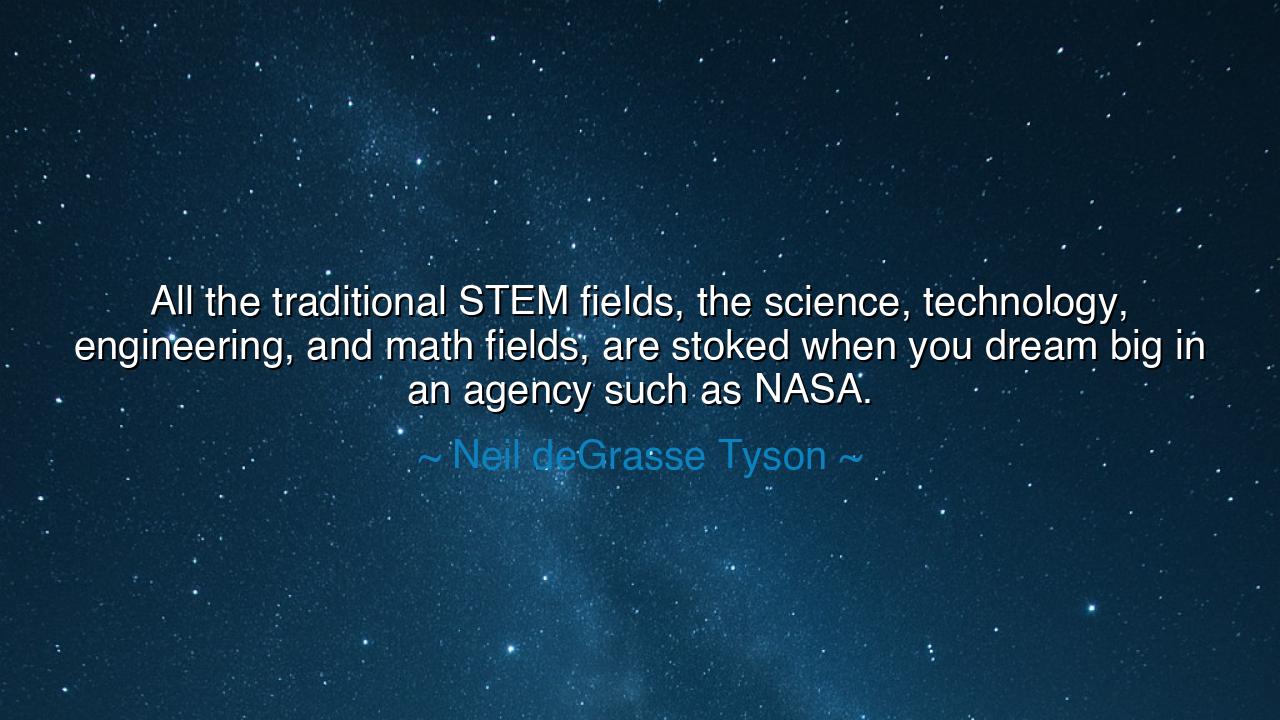
All the traditional STEM fields, the science, technology
All the traditional STEM fields, the science, technology, engineering, and math fields, are stoked when you dream big in an agency such as NASA.






Hear the words of Neil deGrasse Tyson, who with fire in his voice proclaimed: “All the traditional STEM fields, the science, technology, engineering, and math fields, are stoked when you dream big in an agency such as NASA.” These words are not a mere observation, but a summons. They remind us that human progress is not born from timid dreams, but from vast, daring visions that pull every discipline into harmony, as instruments in a great symphony of discovery.
He speaks first of the STEM fields—science, technology, engineering, and math—pillars of knowledge upon which civilization builds its strength. Alone, each is mighty; together, they become unstoppable. Yet Tyson reminds us that they are not ignited by small tasks or cautious goals. It is only when humanity dreams big, when it sets its eyes upon the stars, that these fields blaze to life. For when the horizon expands, every discipline must rise to meet it.
This is why he invokes NASA, not as a mere agency of rockets and satellites, but as a temple of human aspiration. In its halls, biologists ask how life may survive on other worlds. Engineers design ships to withstand the void. Mathematicians chart the paths of planets and trajectories of spacecraft. Technologists forge tools that stretch the very limits of possibility. Each branch, stirred by the audacity of the mission, transcends its ordinary bounds and reaches for the extraordinary.
History itself bears witness. In 1961, when John F. Kennedy declared that America would go to the Moon, it was not merely a call to engineers, but to all minds of science. Suddenly, the dream of reaching the heavens demanded new alloys, new computer systems, new mathematics, and new medical studies for human survival in space. Within a single decade, mankind walked upon the Moon. The feat was not born of one field alone, but of all four standing together, stoked by the fire of a vision greater than themselves.
Yet Tyson’s words remind us that this is not only about NASA. It is about the power of vision itself. When humanity dares to dream—to cure disease, to harness clean energy, to explore the oceans’ depths—it stirs the same fire. Science thrives on mystery, technology thrives on challenge, engineering thrives on necessity, and mathematics thrives on complexity. Give them a small dream, and they labor dutifully. Give them a grand dream, and they will move mountains.
But let us not mistake his meaning. To dream big is not to indulge in idle fantasy. It is to set a vision so bold that it demands the full measure of human skill, creativity, and collaboration. It is to say, “This is impossible today, but let us strive until tomorrow.” Such dreams test our patience, but they also reveal our greatness. Without them, we stagnate; with them, we ascend.
The lesson is clear: do not shrink your dreams to fit the tools you have—expand your tools to meet the size of your dreams. Just as NASA inspired generations of scientists and engineers, so too can any bold vision inspire progress in your own life. If you are a student, let your goals stretch beyond the ordinary, for the pursuit itself will sharpen your mind. If you are a builder, let your projects aim not only to serve today, but to endure for tomorrow. And if you are a dreamer, dare to dream so boldly that it stokes the talents of all who join you.
Thus, Neil deGrasse Tyson’s words echo through time as both wisdom and challenge: that all fields of human knowledge burn brightest when kindled by daring dreams. For it is in the act of dreaming beyond Earth itself that we discover not only new worlds, but also the true measure of our own.






AAdministratorAdministrator
Welcome, honored guests. Please leave a comment, we will respond soon